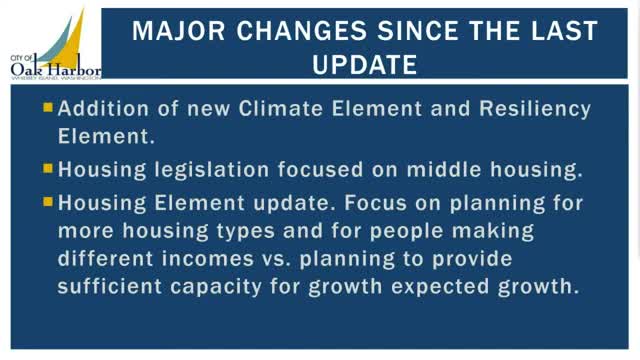City plans major housing overhaul to meet growing demand
August 29, 2024 | Oak Harbor, Island County, Washington
This article was created by AI summarizing key points discussed. AI makes mistakes, so for full details and context, please refer to the video of the full meeting. Please report any errors so we can fix them. Report an error »

In a recent government meeting, officials discussed significant updates to housing legislation aimed at addressing the growing demand for diverse housing options within the community. The new requirements emphasize the need for increased residential infill development, including accessory dwelling units and multi-family housing types such as duplexes and triplexes, particularly in existing neighborhoods.
The meeting highlighted the challenges posed by the new housing element requirements, which necessitate a more detailed analysis of housing capacity not just in terms of quantity, but also in relation to affordability across different income levels. The city is now tasked with planning for approximately 5,500 new housing units, representing a 50% increase from the current stock of around 10,000 units. This increase is particularly focused on accommodating households earning below the area median income (AMI), which is set at $102,000 for the region.
Officials noted that while there is sufficient capacity for single-family homes in lower-density zones, there is a critical shortfall in multi-family housing options that cater to lower-income residents. The discussions underscored a shift in growth management strategies, with a clear directive to concentrate development within city limits rather than in rural areas, where infrastructure is lacking.
The city is currently at a transition point, having completed several preliminary assessments, including a land capacity analysis and a housing needs assessment. Community engagement efforts are underway to gather public input on the proposed housing strategies.
Three potential options for addressing the housing shortfall were presented. The first option involves maintaining existing zoning and development standards, which would still leave a significant shortfall of about 3,000 units. The second option suggests modifying development standards to allow for increased density, potentially reducing the shortfall to 2,400 units. The third option proposes more extensive zoning changes to maximize housing capacity, which could bring the shortfall down to 2,000 units.
Council members expressed concerns about the feasibility of achieving the ambitious housing targets, particularly regarding the availability of land and the economic viability of proposed developments. The discussions also touched on the importance of ensuring that any new housing developments align with community needs and infrastructure capabilities.
As the city moves forward with these housing initiatives, officials emphasized the need for collaboration with county planners to ensure that growth targets are met effectively and sustainably. The outcome of these discussions will play a crucial role in shaping the future housing landscape of the community.
The meeting highlighted the challenges posed by the new housing element requirements, which necessitate a more detailed analysis of housing capacity not just in terms of quantity, but also in relation to affordability across different income levels. The city is now tasked with planning for approximately 5,500 new housing units, representing a 50% increase from the current stock of around 10,000 units. This increase is particularly focused on accommodating households earning below the area median income (AMI), which is set at $102,000 for the region.
Officials noted that while there is sufficient capacity for single-family homes in lower-density zones, there is a critical shortfall in multi-family housing options that cater to lower-income residents. The discussions underscored a shift in growth management strategies, with a clear directive to concentrate development within city limits rather than in rural areas, where infrastructure is lacking.
The city is currently at a transition point, having completed several preliminary assessments, including a land capacity analysis and a housing needs assessment. Community engagement efforts are underway to gather public input on the proposed housing strategies.
Three potential options for addressing the housing shortfall were presented. The first option involves maintaining existing zoning and development standards, which would still leave a significant shortfall of about 3,000 units. The second option suggests modifying development standards to allow for increased density, potentially reducing the shortfall to 2,400 units. The third option proposes more extensive zoning changes to maximize housing capacity, which could bring the shortfall down to 2,000 units.
Council members expressed concerns about the feasibility of achieving the ambitious housing targets, particularly regarding the availability of land and the economic viability of proposed developments. The discussions also touched on the importance of ensuring that any new housing developments align with community needs and infrastructure capabilities.
As the city moves forward with these housing initiatives, officials emphasized the need for collaboration with county planners to ensure that growth targets are met effectively and sustainably. The outcome of these discussions will play a crucial role in shaping the future housing landscape of the community.
View full meeting
This article is based on a recent meeting—watch the full video and explore the complete transcript for deeper insights into the discussion.
View full meeting
